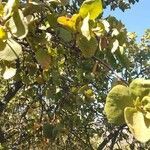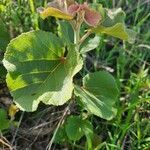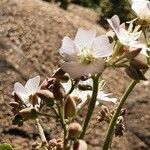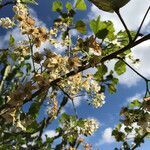Leaf-lamina 3–15 cm. in diam., leathery, broadly ovate to suborbicular, apex rounded or more rarely acute, margin irregularly dentate or subentire, base cordate and 5–7-nerved, scaberulous with minute appressed stellate hairs above, pale-tomentellous below, nerves prominent below, veins prominent and reticulate; petiole up to 8 cm. long but usually less, tomentellous; stipules c. 3 mm. long, very caducous, narrowly lanceolate-acuminate, pubescent.
A softy hairy tree. It grows up to 9 m tall. It has many branches and loses its leaves during the year. The leaves are large, leathery and rounded with a heart shaped base. The flowers are pink or white and in branched clusters. The flowers usually occur when the tree is without leaves. The fruit are small and dark. They are the size of an olive.
Flowers white or more rarely pink, in many-flowered axillary panicles, often appearing before the leaves; peduncle often very short, up to c. 3 cm. long, slender, floccose-tomentellous; pedicels up to c. 1·5 cm. long, with a similar indumentum; bracts 2–A mm. long, very caducous, linear-lanceolate, tomentose.
Ovary depressed-globose, tomentose; loculi glabrous within; ovules 2 or rarely 3 per loculus; style c. 2 mm. long, sparsely pilose, at least near the base; stigmas 3 or rarely 5, c. 1·5 mm. long, spreading or recurved.
Shrub or small tree up to c. 8 m. tall; bark dark and rough; buds ferruginously tomentose; young branches thinly tomentose but soon glabrous.
Stamens joined below in a very short tube 0·5–1 mm. long; staminodes 6–9 mm. long, filamentous to linear-lanceolate, glabrous.
Calyx-lobes c. 7 × 2·5 mm., lanceolate-acuminate, tomentellous or densely pubescent outside.
Seeds brown, c. 3 × 2·5 mm., trigonous; testa slightly wrinkled.
Petals c. 1 × 0·7 cm., very obliquely triangular-obovate.
Capsule c. 6 mm. in diam., globose, tomentose.







